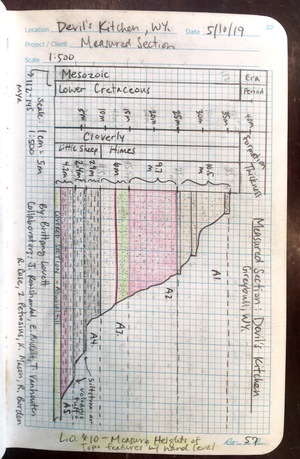Geoscience student plans career as professional geologist

CHADRON – Brittany Lovett, a Chadron State College senior studying geoscience online from Klamath Falls, Oregon, is pursuing a lifelong passion.
“I probably drove my family crazy collecting jars of rocks,” Lovett said.
A native of California, she earned a liberal arts degree from Allan Hancock College in Santa Maria, California, about 14 years ago. After working jobs in the service and retail industry, she decided she wanted to look for an academic program she was passionate about.
She found only a handful of online Bachelor of Science programs in geology or geoscience nationwide. One focused on environmental policy and law, but she wanted a core science curriculum. Then she discovered CSC.
“Chadron had just what I wanted. Most field camps aren’t offered until the junior year and then they are six weeks long or offered by a third party. CSC broke it up into two-week increments,” Lovett said. “The icing on the cake was the flat rate instead of higher tuition for out of state students.”
Lovett said she has received excellent guidance from faculty members Dr. Mike Leite, Dr. Mary Keithly, and Dr. Tawny Tibbits.
“The professors, each and every one, are so amazing,” Lovett said.
In 2017, Lovett and the other students in her initial Field Camp cohort studied the Red Rocks Open Space, Black Canyon of the Gunnison National Park in Colorado, and three National Parks in Utah: Arches, Canyon Land, and Zion. The students learned how land forms were shaped, practiced rock identification, and learned how to map geologic features.
“It was my first exposure to field work. You learn so much so fast and see some beautiful areas. Field camp was a bonding experience. I made great friends along the way,” Lovett said.
The second field camp mirrored the one the year before with some subtle differences. The class visited Garden of the Gods and mapped it, searched for tourmaline in the Brown Derby Mine, and made geologic maps of Devil’s Canyon. Lovett and her husband, Tyson, were also expecting their first child.
When Lovett completed her third two-week field camp to Yellowstone and the Grand Tetons in 2019, she had a five-month-old son, Bobby, in tow. Tyson and Bobby followed the CSC field camp route in a separate vehicle.
“We made it a family trip. Everyone got to meet Tyson and some of them played with Bobby, especially around supper time before we split up to do homework,” said Lovett, who gave birth to a second son, Miles, in December 2020.
She said the notebooks she compiled on each trip improved with experience. She still uses them for reference.
Leite ties the field camp work back to class assignments. Lovett said they often stopped to study road cuts, exposed rock layers created by construction of highways.
“From the surface a fault often looks like a fracture or crack in the rock. We were able to see faults occasionally on roadcuts. Unlike a simple fracture or crack, faults are a displacement of blocks of rock. Sometimes you can also find striations or a polished surface on the fault plane called slickensides. This can help you determine the direction the rocks have shifted,” Lovett said.
By entering two-dimensional data points into specialized software, the students were able to map three- dimensional rock structures.
“The stereonet is a tool geologists designed to represent something three-dimensional on a two-dimensional map. You measure the orientation of the rock in a number of places, and then plot those measurements onto the stereonet. This lets you see the overall orientation of the rock.” Lovett said.
For Lovett’s capstone project she rented a portable X-ray Fluorescence (pXRF) unit and collected data from mudstone rocks in the Tecopa region of Death Valley in January 2020. She analyzed specimens for research funded by a NASA Nebraska grant that could help determine through geochemical indicators if similar rocks on Mars might have been biologically formed. One of the major goals of the mission of the Mars Perseverance rover, equipped with a pXRF unit, is to find traces of past life on Mars.
“You obtain a lot of data fast. Different rocks give off a secondary florescence that is visually different. It saves a lot of time because you don’t have to wait to send your rock samples to a lab to have them analyzed,” she said. “The data collection itself was not all that complicated. The analysis afterward takes much more time.”
She presented her pXRF research virtually in April 2020 to the Nebraska Academy of Science.
Lovett is studying to take the Association of State Boards of Geology exam so she can become a licensed geologist in Oregon. She hopes to find a position with the National Forest Service, the United States Geological Survey, or similar entity. She may eventually enter graduate school.
—Tena L. Cook, Marketing Coordinator
Category: Campus News, Physical and Life Sciences



